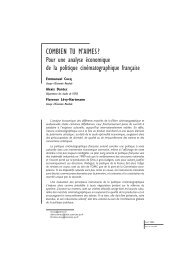direct multi-step estimation and forecasting - OFCE - Sciences Po
direct multi-step estimation and forecasting - OFCE - Sciences Po
direct multi-step estimation and forecasting - OFCE - Sciences Po
Create successful ePaper yourself
Turn your PDF publications into a flip-book with our unique Google optimized e-Paper software.
Direct <strong>multi</strong>-<strong>step</strong> <strong>estimation</strong> <strong>and</strong> <strong>forecasting</strong><br />
They show that<br />
( )<br />
T (̂ρ 1 S ) h − 1<br />
T<br />
( )<br />
(̂ρ IV ) h − 1<br />
T (˜ρ DMSh − 1 )<br />
T (˜ρ IV DMSh − 1 )<br />
⇒<br />
⇒<br />
⇒<br />
⇒<br />
(∫ 1<br />
−1<br />
W (r) dr) 2 h<br />
0<br />
(∫ 1<br />
0<br />
[<br />
1<br />
( )<br />
W (1) 2 − 1 +<br />
2<br />
) −1<br />
W (r) 2 h<br />
( )<br />
dr W (1) 2 − 1 ,<br />
2<br />
(∫ 1<br />
−1<br />
W (r) dr) 2 h<br />
0<br />
(∫ 1<br />
0<br />
[<br />
1<br />
( )<br />
W (1) 2 − 1 +<br />
2<br />
) −1<br />
W (r) 2 h<br />
( )<br />
dr W (1) 2 − 1 ,<br />
2<br />
]<br />
θ<br />
(1 + θ) 2 ,<br />
]<br />
θ<br />
h (1 + θ) 2 ,<br />
<strong>and</strong> provide small sample approximations of the distributions. The leftward non-centrality of IMS<br />
therefore increases with h, whereas that of DMS does not.<br />
The instrumental estimators seem<br />
better. Simulations illustrate these results.<br />
This framework is also analysed in Chevillon <strong>and</strong> Hendry (2005) who now allow for a drift in the<br />
r<strong>and</strong>om walk. This induces the presence of a deterministic trend which asymptotically dominates<br />
<strong>estimation</strong>, yielding the same asymptotic accuracy for both methods. In finite sample though,<br />
disparities appear: DMS is more accurate when the drift is ‘small’ compared to the variance of the<br />
disturbances <strong>and</strong> when the latter exhibit negative serial correlation. Introducing the concept of<br />
‘weak’ trend whereby the drift coefficient vanishes to zero asymptotically at the rate of O ( T −1/2) ,<br />
Chevillon (2005b) derives asymptotic distributions where he allows for both the stochastic <strong>and</strong><br />
deterministic trends to have an impact on <strong>estimation</strong>. The model he uses is:<br />
( h−1<br />
) ∑<br />
y t = ρ i τ T + ρ h y t−h + ε t , for h ≥ 1,<br />
i=0<br />
where τ T = √ ψ<br />
[ ∑T<br />
]<br />
(<br />
, Var[ε t ] = σ ε <strong>and</strong> σ 2 = lim T →∞ T −1 E<br />
t=1 ε t . The resulting IMS,<br />
T<br />
<strong>and</strong> DMS, (˜τ )<br />
h,T , ˜ρ h,T , estimators are such that<br />
⎡<br />
⎤ ⎡<br />
√ √ ) ⎤<br />
⎢ T (˜τ h,T − τ h,T ) ⎥ ⎢ T<br />
(̂τ {h}<br />
[∫<br />
T<br />
− τ 1 h,T ⎥<br />
(h − 1) θ<br />
⎣<br />
T (˜ρ h,T − 1 ) ⎦−⎣<br />
( ) ⎦ ⇒<br />
0<br />
T ̂ρ h ∫ ( 1 ∫ ) K ]<br />
ψ,φ (r) dr<br />
T − 1<br />
0 [K ψ,φ (r)] 2 1 2<br />
,<br />
dr −<br />
0 K −1<br />
ψ,φ (r) dr<br />
where K ψ,φ is a drifting Ornstein-Uhlenbeck process defined as<br />
K ψ,φ (r) = ψf φ (r) + σ<br />
∫ r<br />
0<br />
e φ(r−s) dW (s) ,<br />
with W (r) a Wiener process on [0, 1] <strong>and</strong>:<br />
̂τ {h}<br />
T<br />
, ̂ρh T<br />
)<br />
,<br />
(18)<br />
f φ (·) : r → eφr − 1<br />
φ<br />
if φ ≠ 0, <strong>and</strong> f 0 (r) = r. (19)<br />
32








